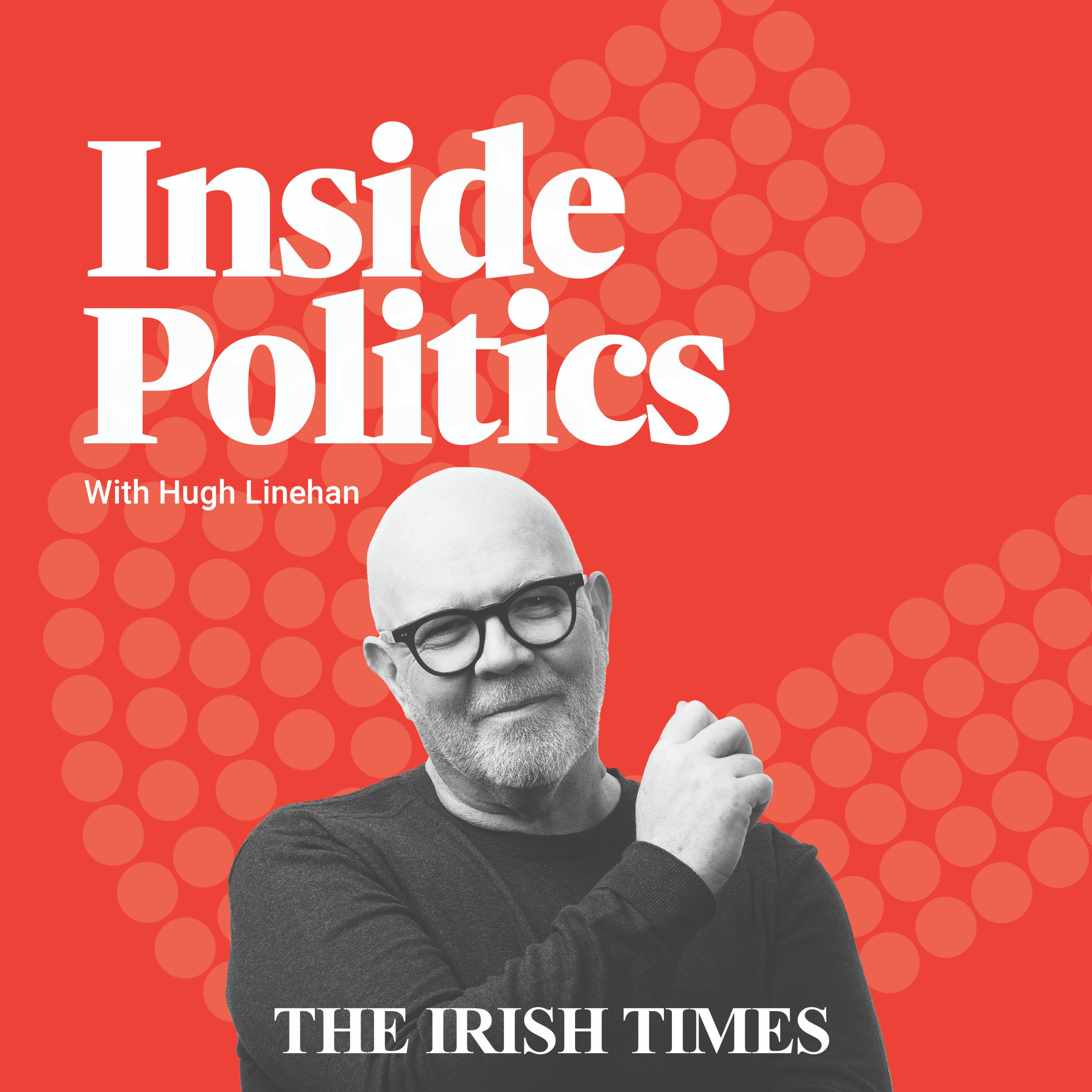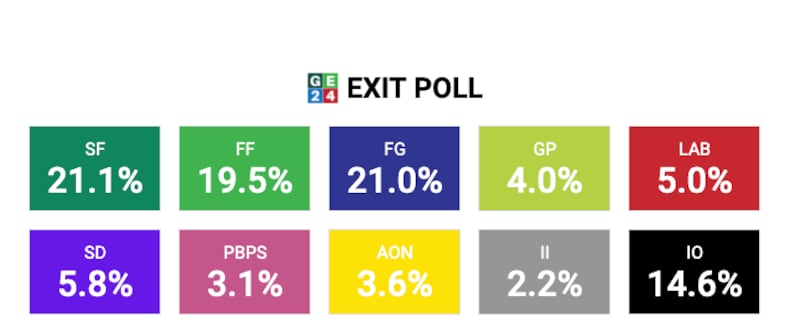The results of the general election 2024 exit poll suggest Fine Gael and Fianna Fáil will be in the driving seat to re-establish their coalition – though which party, or parties, or Independents, that might accompany them is likely to remain unclear for some time.
If the results are borne out when the actual votes are counted Fine Gael and Fianna Fáil are likely to approach 75-80 seats between them, assuming a decent seat bonus, and a strong transfer between the two parties.
Those transfers will assume a high degree of importance as the counts unfold in coming days.
Naturally, supporters of both parties transferred at higher rates to running mates from the same party. For Fine Gael voters it was at a rate of 37 per cent to other Fine Gael candidates. Fianna Fáil candidates were the second preference choice of 39 per cent of Fianna Fáil voters.
READ MORE
But once they have voted for their own party, they are transferring to their government partners in large numbers. The poll – conducted by Ipsos/B&A on Friday for The Irish Times/RTÉ/TG4/TCD, finds that among Fine Gael voters 32 per cent said their second preference votes went to Fianna Fáil, while 30 per cent of Fianna Fáil voters said they transferred to Fine Gael.
Sinn Féin voters transferred at a rate of 48 per cent to second candidates from the same party. The next highest second preference votes from Sinn Féin supporters was to Independents. But the party is having a harder job attracting transfers from other parties.
The highest second preference transfer rates between arch-rivals Labour and the Social Democrats were to each other. According to the exit poll some 22 per cent of second preferences from Labour voters went to the Social Democrats. Second preferences from Social Democrats supporters went to Labour at a rate of 23 per cent. Perhaps their voters are not as hostile to each other as the parties’ elected representatives sometimes seem to be.
The results of the exit poll suggest Fine Gael’s campaign – which stuttered for much of the last three weeks – may have recovered in the final days.
While 21 per cent would represent the evaporation of the so-called ‘Harris Hop’ that saw the party reach as high as 27 per cent support levels in The Irish Times/Ipsos B&A poll in September, it is likely to be greeted with relief by the party leadership.
There were fears in the party during the past week that a collapse in the party’s vote might be under way – so while it is not the result that it anticipated or hoped for at the beginning of the campaign, the party will know it could have been worse.
Frankly, Fine Gael had a poor election campaign. It was on the defensive from the first weekend after Ryanair boss Michael O’Leary’s controversial remarks about teachers at a campaign launch for Fine Gael minister Peter Burke. For reasons best known to itself it persisted with John McGahon as a candidate.
Then there was the Taoiseach Simon Harris’ blunder where he appeared dismissive in a campaign trail exchange with disabilities worker Charlotte Fallon in Kanturk, Co Cork. An apology from Mr Harris followed but the moment was seized upon by his political opponents and Fine Gael was on damage limitation for days. It was probably the standout moment of the campaign.

EXIT POLL: What do the results mean for government formation?
But perhaps more damaging was a sort of strategic incoherence in Fine Gael’s message. The party embarked on a series of costly promises in the first half of the campaign, including the abolition of the means test for the carers’ allowance (which civil servants estimate could escalate to some €2 billion a year), the abolition of university fees, a €1,000 grant for every baby, double child benefit every August, etc.
These were an understandable reaction to public concern on the cost of living. But they sat awkwardly with the fears of the possible impact of the new Trump administration on corporation tax revenues here – and the claims that only Fine Gael had the instincts of prudence necessary for the potentially difficult times ahead.
In the end, the tactic of putting Paschal Donohoe out front for every day of the last week may have helped turn things around.
Fianna Fáil took a narrow lead in opinion polls published over the last week, so will be disappointed to come in third – if that is borne out by the results.
Party leader Micheál Martin – who had a solid, if unspectacular, campaign – consistently argues that Fianna Fáil outperforms opinion polls. The party will hope its greater number of incumbent candidates than Fine Gael and the possibility of getting transfers from its Coalition partner will push it over 20 per cent and ahead of its rivals.
For Sinn Féin there will be relief that the string of controversies it faced in the build up to the election campaign appear not to have overly damaged the party’s current support levels.

The exit poll result is a far cry from the 36 per cent the party had in The Irish Times poll from July 2022, but it is considerably better than the just under 12 per cent of first preference share the party got in June’s local election. Mary Lou McDonald was a dynamo on the campaign trail. But in a series of difficult moments in interviews and debates, she also clearly conveyed the party’s shortcomings – the difficulty of outlining exactly what “change” would mean in real terms.
However, if the exit poll proves correct, it’s hard to see how the party has a route to government. It could well finish first in the popular vote for the second time in a row, but face another five years in opposition.
The next Dáil is set to have more Independent TDs returned – but the tsunami of new independent TDs predicted by some is unlikely on the basis of these numbers.
There were 21 Independents elected in 2020 on just over 13 per cent of the vote so the 12.7 per cent, plus the 2.2 per cent for new party Independent Ireland in the exit poll would indicate that their numbers will grow. But the Independent Ireland showing – though surely many of its most prominent members will return to the next Dáil – will be a disappointment to the founders who believed they were set to become a new force in Irish politics. Not on the basis of these numbers.
The three centre left parties, the Green Party, Labour and the Social Democrats, are all bunched on between 4 and 5.8 per cent.
The Green Party is down substantially from the 7 per cent it got in the 2020 general election, but if the exit poll result is correct, it may hold more seats than might have been expected. Like all small parties though, it will be on a knife edge in many constituencies.
The Social Democrats are ahead of arch rivals Labour – which will delight them. But observers will doubtless point out that their combined support of nearly 11 per cent would make them the clear second party of opposition.
People Before Profit Solidarity is close enough to the 2.6 per cent of the vote it got in 2020.
Peadar Tóibín’s Aontú had an excellent campaign and looks on course to substantially improve on its 2020 vote share of just under 2 per cent, with 3.6 per cent in the exit poll. That gives it a real shot of increasing its Dáil numbers – but it’s impossible to predict the individual constituency fortunes of any of the small parties from these big national numbers.
The exit poll was conducted among 5,018 voters at more than 200 locations nationwide, as they left polling stations. It has a margin of error of 1.4 per cent.
- Sign up for push alerts and have the best news, analysis and comment delivered directly to your phone
- Join The Irish Times on WhatsApp and stay up to date
- Listen to our Inside Politics podcast for the best political chat and analysis
- Sign up to our Inside Politics newsletter to get the behind-the-scenes take direct to your inbox











